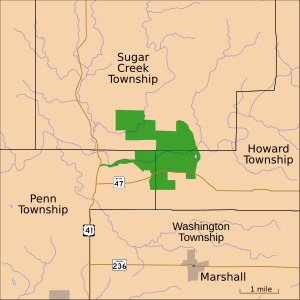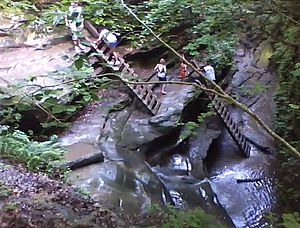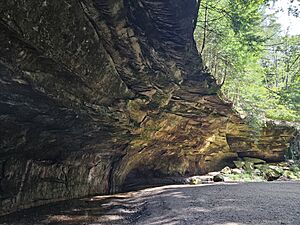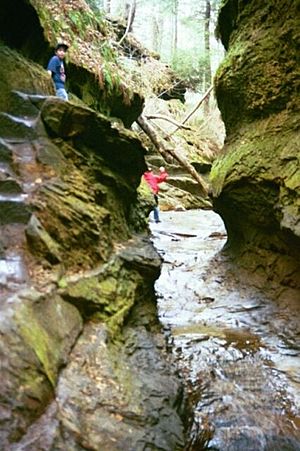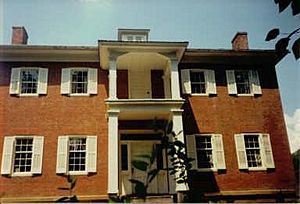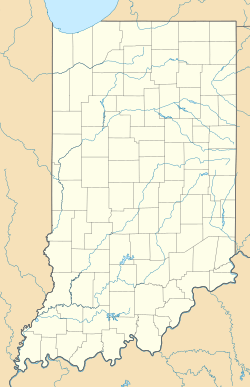Turkey Run State Park facts for kids
Quick facts for kids Turkey Run State Park |
|
|---|---|
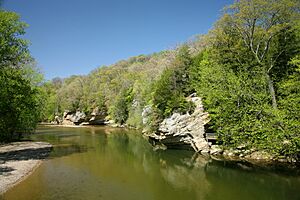
Sugar Creek in Turkey Run State Park
|
|
| Lua error in Module:Location_map at line 420: attempt to index field 'wikibase' (a nil value). | |
| Type | State park |
| Location | Parke County, Indiana, USA |
| Nearest city | Marshall, Indiana |
| Area | 2,382 acres (964 ha) |
| Created | 1916 |
| Operated by | Indiana Department of Natural Resources |
| Visitors | 706,323 (in 2018–2019) |
| Website | Official Website: http://www.in.gov/dnr/parklake/2964.htm |
Turkey Run State Park is an amazing place in Parke County, Indiana. It's Indiana's second state park, located in the west-central part of the state. You can find it about 2 miles (3.2 km) east of U.S. 41 on State Road 47.
The park was created in 1916, the same year Indiana celebrated 100 years of being a state. The first piece of land for the park cost $40,200. No one is completely sure how the park got its name, "Turkey Run." The most popular idea is that wild turkeys used to gather in the warm, sheltered gorges (which people called "runs"). This made it easy for early settlers to hunt and trap them.
Turkey Run State Park offers lots of fun things to do. It has many hiking trails, a special nature preserve called Rocky Hollow Falls Canyon, and a cool suspension bridge over Sugar Creek. You can also find camping spots and other places for outdoor activities. The park is home to the historic Lusk Home and Mill Site and the Richard Lieber Log Cabin. Both of these sites are listed on the National Register of Historic Places. The park itself was added to the National Register in 2019. About 700,000 people visit Turkey Run every year!
On April 8, 2024, Turkey Run State Park was one of the best places in Indiana to see a total solar eclipse. Visitors to the park experienced 43 seconds of complete darkness during the day!
Contents
Exploring Turkey Run's Past
Native Americans and Early Settlers
The land where Turkey Run State Park now sits was once the home of several Native American groups. These included the Kiikaapoi, Peoria, Potawatomi, and Myaamia peoples. Later, France claimed control of the area, followed by the British after a peace treaty in 1763.
The area became known as Turkey Run because of the many wild turkeys. These birds would hide in the warm, deep gorges during cold weather. This made it simple for early settlers to find and hunt them.
The first white family to live in this wooded area was the Salmon Lusk family. Captain Salmon Lusk fought in a famous battle in 1811. He received land at Turkey Run for his service. His son, John Lusk, later owned the property. John loved nature and refused to sell the land to lumber companies, even though they offered a lot of money. In 1882, he did allow a railroad company to open a summer resort there. The resort stayed open until John Lusk passed away in 1915.
Saving the Forest: How Turkey Run Became a Park
In April 1915, people learned that the beautiful forest at Turkey Run was going to be sold. A local writer named Juliet V. Strauss wrote a letter to Indiana's governor, Samuel M. Ralston. She asked him to save the 2,382 acres (964 hectares) of forest from being cut down. Her letter helped convince the governor to create a special group, the Turkey Run Commission, to protect the forest. Strauss herself was appointed to this commission.
Richard Lieber, a conservationist, also became very interested in saving Turkey Run. He wanted to create a system of state parks to celebrate Indiana's 100th birthday as a state. In November 1915, Lieber talked to Governor Ralston about this idea. The governor agreed, and Lieber joined the Turkey Run Commission.
The state parks committee decided to raise money from people to buy the land. They needed $25,000. Many people donated, and they collected about $20,000.
The Park is Born
Even with all the effort, the state didn't win the auction for Turkey Run on May 18, 1916. A lumber company bought the land for $30,200. But Richard Lieber didn't give up! He talked with the lumber company and made a deal to buy the land for $40,200 on November 11, 1916. Much of this money came from private donations. The Indianapolis Motor Speedway Association gave $5,065, and a car racing fan named Arthur C. Newby gave another $5,000.
While they were working to buy Turkey Run, Lieber and his committee bought another piece of land. This became McCormick's Creek State Park, Indiana's very first state park. When Turkey Run was finally bought in November 1916, it became Indiana's second state park. In 2019, Turkey Run State Park was officially added to the National Register of Historic Places.
Park Location and Unique Landscape
Turkey Run State Park is about 5 miles (8.0 km) southwest of Shades State Park. Both parks are located along Sugar Creek. They both have amazing gorge systems. These gorges were formed as the creek slowly cut through the sandstone rock. The specific type of sandstone at Turkey Run is called Mansfield sandstone.
You can see cool geological features here, like "The Punchbowl" on Trail 3. This is a large hole in the rock that was carved out by swirling water and rocks during the Ice Age.
Awesome Trails and Water Fun
Turkey Run has many trails for hikers. In the summer, when the creeks are low, it's a great time to explore. A long suspension bridge crosses Sugar Creek, letting you reach trails on the other side. Trail 3 is known for being very rugged, with ladders and deep, narrow gorges.
Floating down Sugar Creek in inner tubes, canoes, or kayaks is super popular in the summer. You can choose trips that are 3-mile (4.8 km), 8-mile (13 km), or even 11-to-15-mile (18 to 24 km) long. In spring, after heavy rains or snow melt, the gorges can flood. Some adventurous hikers like to "creek stomp" through the water. But be careful! The fast current and slippery creek beds can make this dangerous when water levels are high.
How the Park's Landscape Was Formed
The main features of Turkey Run State Park are carved from Mansfield sandstone. This rock formed millions of years ago during the Carboniferous period. It was created from sediments at the mouth of an ancient river. This area was once a swampy environment, which also formed coal deposits. You can still see a collapsed entrance to an old coal mine in the park.
Later, during the Ice Age (the Pleistocene Epoch), melting glaciers played a huge role. The powerful meltwaters carved the Mansfield sandstone into the unique shapes we see today. You can also find large rocks left behind by glaciers, called glacial erratics, and other glacial deposits.
Rocky Hollow Falls Canyon Nature Preserve
The Rocky Hollow Falls Canyon Nature Preserve is a series of amazing canyons cut into the sandstone. Rocky Hollow is the longest canyon, and Falls Canyon has the park's only waterfall (which flows mostly after rain). There are six trails through this preserve, each with its own special mini-climate. Depending on the season, these trails can be muddy, hard to pass, or wonderfully cool on a hot day. The park's suspension bridge, first built in 1917–18, leads right to this preserve.
Rocky Hollow starts high up at 680 feet (210 m) and drops down to 540 feet (160 m) at Sugar Creek. Bear Hollow and Falls Canyon drop similar distances but in shorter lengths. This nature preserve was recognized as a National Natural Landmark in 1974.
The Historic Lusk Home and Mill Site
The Lusk Home and Mill Site is an important historical spot within the park. It's listed on the National Register of Historic Places. The park actually grew around this area. Salmon Lusk built his home here in 1841. He also built a mill on the site in 1826. The Lusk home and mill site were added to the National Register in 1974.
The Richard Lieber Log Cabin
|
Richard Lieber Log Cabin
|
|
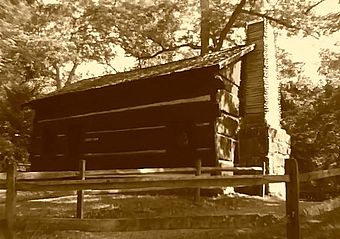
Richard Lieber Cabin, September 2012
|
|
| Location | Marshall, Indiana |
|---|---|
| Architect | Daniel Gay, Richard Lieber |
| NRHP reference No. | 01000403 |
| Added to NRHP | May 4, 2001 |
The Richard Lieber Log Cabin is another historic site at Turkey Run listed on the National Register of Historic Places. It was built in 1848 using native tulip trees. It's one of the oldest cabins of its kind in Indiana. The Lieber Cabin was added to the National Register in 2001.
The cabin is named after Colonel Richard Lieber. He was the first director of Indiana's state parks system. He worked hard to create the state parks as a lasting memory of Indiana's 100th birthday. Lieber found the cabin in 1918 and convinced its owner to move it 3 miles (4.8 km) to the park. It then became the park's administration building. Today, the cabin is a museum that honors Lieber and the Indiana state park system.
Other Park Features
Campsites at Turkey Run were first created in 1964. The state park also has the Turkey Run Inn and cabins for people who want to stay overnight. The inn was built around 1919, with additions made later. The Civilian Conservation Corps (CCC), a group that helped people find work during the Great Depression, built five cabins near the inn in 1941. They also built a Nature Center at Turkey Run in 1942, which was originally a store.
Gallery
-
Cox Ford Covered Bridge at Turkey Run
See also
- Arch in the Town of Marshall
- Beeson Covered Bridge
- Parke County Covered Bridges
- National Register of Historic Places listings in Parke County, Indiana
- Parke County Covered Bridge Festival


